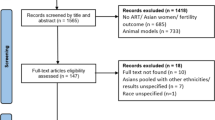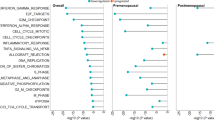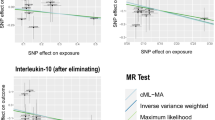Abstract
Purpose
Poor response to ovarian stimulation (POR) typically is reflected as decreased follicular response and low estradiol (E2) levels following ovarian stimulation by FSH/HMG. Many genes are involved in oocyte maturation, and demographic features and lifestyle can affect the oocyte maturity and developmental competence. The present study was conducted to investigate the magnitude of gene expression and lifestyle habits in POR women as compared to healthy women, using different statistical and computational methods.
Methods
Fifty women in the two groups were studied. The study groups included POR women (n = 25) with 1–9 released oocytes, and the control group (normal women, n = 25) with 9–15 released oocytes. Quantitative PCR was used to estimate the expression of FIGLA, ZAR1, WNT4, LHX8, APC, H1FOO, MOS, and DMC1 genes in granulosa cells.
Results
The results showed no significant difference in the magnitude of the studied genes’ expression and linear discriminant analysis did not differentiate the studied groups based on all the genes together. Redundancy analysis (RDA) and latent factor mixed model (LFMM) results produce no significant association between the genes’ expression magnitude and the geographical variables of the patients’ local habitat. Linear discriminant analysis (LDA) of the demographic features differentiated the two groups of women.
Conclusion
Our results indicate that demographic features may have an effect on sample gene expression levels.







Similar content being viewed by others
Data availability
The current study is not publicly available due to personal document confidentiality. Data are available from the corresponding author on request.
Abbreviations
- POR:
-
Poor response to ovarian stimulation
- OS:
-
Ovarian stimulation
- ART:
-
Assisted reproductive technology
- ICSI:
-
Intracytoplasmic sperm injection
- AMH:
-
Anti-mullerian hormone
- AFC:
-
Antral follicle count
- PBS:
-
Phosphate-buffered saline
- ANOVA:
-
Analysis of variance
- KEGG:
-
Kyoto Encyclopedia of Genes and Genomes
References
Ferraretti AP, La Marca A, Fauser BC, et al. ESHRE consensus on the definition of “poor response” to ovarian stimulation for in vitro fertilization: the Bologna criteria. Hum Reprod. 2011. https://doi.org/10.1093/humrep/der092.
Nagels HE, Rishworth JR, Siristatidis CS, Kroon B. Androgens (dehydroepiandrosterone or testosterone) for women undergoing assisted reproduction. Cochrane Database Syst Rev. 2015. https://doi.org/10.1002/14651858.CD009749.pub2.
Pandian Z, McTavish AR, Aucott L, Hamilton MP, Bhattacharya S. Interventions for ‘poor responders’ to controlled ovarian hyper stimulation (COH) in in-vitro fertilisation (IVF). Cochrane Database Syst Rev. 2010. https://doi.org/10.1002/14651858.CD004379.pub3.
Patrizio P, Vaiarelli A, Levi Setti PE, et al. How to define, diagnose and treat poor responders? Responses from a worldwide survey of IVF clinics. Reprod Biomed Online. 2015. https://doi.org/10.1016/j.rbmo.2015.03.002.
Humaidan P, Alviggi C, Fischer R, Esteves SC. The novel POSEIDON stratification of ‘Low prognosis patients in Assisted Reproductive Technology’ and its proposed marker of successful outcome. F1000Res. 2016. https://doi.org/10.12688/f1000research.10382.
Rodrigues P, Limback D, McGinnis L, Marques M, Aibar J, Plancha CE. Germ-somatic cell interactions are involved in establishing the follicle reserve in mammals. Front Cell Dev Biol. 2021. https://doi.org/10.3389/fcell.2021.674137.
Sang Q, Zhou Z, Mu J, Wang L. Genetic factors as potential molecular markers of human oocyte and embryo quality. J Assist Reprod Genet. 2021;38(5):993–1002. https://doi.org/10.1007/s10815-021-02196-z.
Fei CF, Zhou LQ. Gene mutations impede oocyte maturation, fertilization, and early embryonic development. BioEssays. 2022. https://doi.org/10.1002/bies.202200007.
Havelock JC, Rainey WE, Carr BR. Ovarian granulosa cell lines. Mol Cell Endocrinol. 2004. https://doi.org/10.1016/j.mce.2004.04.018.
Meczekalski B. Oocyte-specific genes: role in fertility and infertility. J Endocrinol Invest. 2009. https://doi.org/10.1007/BF03346489.
Rong Y, Ji SY, Zhu YZ, Wu YW, Shen L, Fan HY. ZAR1 and ZAR2 are required for oocyte meiotic maturation by regulating the maternal transcriptome and mRNA translational activation. Nucleic Acids Res. 2019. https://doi.org/10.1093/nar/gkz863.
Tanaka M, Kihara M, Hennebold JD, et al. H1FOO is coupled to the initiation of oocytic growth. Biol Reprod. 2005. https://doi.org/10.1095/biolreprod.104.032474.
Ren Y, Suzuki H, Jagarlamudi K, et al. Lhx8 regulates primordial follicle activation and postnatal folliculogenesis. BMC Biol. 2015. https://doi.org/10.1186/s12915-015-0151-3.
Bernard P, Harley VR. Wnt4 action in gonadal development and sex determination. Int J Biochem Cell Biol. 2007. https://doi.org/10.1016/j.biocel.2006.06.007.
Ayala-Calvillo E, Mojica-Vázquez LH, García-Carrancá A, González-Maya L. Wnt/β catenin pathway activation and silencing of the APC gene in HPV positive human cervical cancer derived cells. Mol Med Rep. 2018. https://doi.org/10.3892/mmr.2017.7853.
He W-B, Tu C-F, Liu Q, et al. DMC1 mutation that causes human non-obstructive azoospermia and premature ovarian insufficiency identified by whole-exome sequencing. J Med Genet. 2018. https://doi.org/10.1136/jmedgenet-2017-104992.
Schmidt A, Rauh NR, Nigg EA, Mayer TU. Cytostatic factor: an activity that puts the cell cycle on hold. J Cell Sci. 2006. https://doi.org/10.1242/jcs.02919.
Fu L, Zhang M, Mastrantoni K, Perfetto M, Wei S, Yao J. Bovine Lhx8, a germ cell-specific nuclear factor, interacts with FIGLA. PLoS One. 2016. https://doi.org/10.1371/journal.pone.0164671.
Maged AM, Fahmy RM, Rashwan H, et al. Effect of body mass index on the outcome of IVF cycles among patients with poor ovarian response. Int J Gynaecol Obstet. 2019. https://doi.org/10.1002/ijgo.12706.
Aftabsavad S, Noormohammadi Z, Moini A, Karimipoor M. Effect of bisphenol A on alterations of ICAM-1 and HLA-G genes expression and DNA methylation profiles in cumulus cells of infertile women with poor response to ovarian stimulation. Sci Rep. 2021. https://doi.org/10.1038/s41598-021-87175-1.
Livak KJ, Schmittgen TD. Analysis of relative gene expression data using real-time quantitative PCR and the 2(-Delta Delta C(T)) method. Methods. 2001. https://doi.org/10.1006/meth.2001.1262.
Safarinejad MR. Infertility among couples in a population-based study in Iran: prevalence and associated risk factors. Int J Androl. 2008. https://doi.org/10.1111/j.1365-2605.2007.00764.x.
Badawy A, Wageah A, El Gharib M, Osman EE. Prediction and diagnosis of poor ovarian response: the dilemma. J Reprod Infertil. 2011;12(4):241–8.
Nazni P. Association of western diet & lifestyle with decreased fertility. Indian J Med Res. 2014;140 Suppl(Suppl 1):S78–81.
Agca C, Yakan A, Agca Y. Estrus synchronization and ovarian hyper-stimulation treatments have negligible effects on cumulus oocyte complex gene expression whereas induction of ovulation causes major expression changes. Mol Reprod Dev. 2013. https://doi.org/10.1002/mrd.22141.
Bragança GM, Batista RITP, Souza-Fabjan JMG, et al. Dose and administration protocol for FSH used for ovarian stimulation affects gene expression in sheep cumulus-oocyte complexes. Reprod Fertil Dev. 2018. https://doi.org/10.1071/RD17337.
Bogacki M, Wasielak M, Kitewska A, Bogacka I, Jalali BM. The effect of hormonal estrus induction on maternal effect and apoptosis-related genes expression in porcine cumulus-oocyte complexes. Reprod Biol Endocrinol. 2014. https://doi.org/10.1186/1477-7827-12-32.
Bayne RA, Martins da Silva SJ, Anderson RA. Increased expression of the FIGLA transcription factor is associated with primordial follicle formation in the human fetal ovary. Mol Hum Reprod. 2004. https://doi.org/10.1093/molehr/gah056.
Wang Z, Liu CY, Zhao Y, Dean J. FIGLA, LHX8, and SOHLH1 transcription factor networks regulate mouse oocyte growth and differentiation. Nucleic Acids Res. 2020. https://doi.org/10.1093/nar/gkaa101.
Shen C, Sheng Q, Zhang X, Fu Y, Zhu K. Hypermethylated APC in serous carcinoma based on a meta-analysis of ovarian cancer. J Ovarian Res. 2016. https://doi.org/10.1186/s13048-016-0271-6.
Snider AP, Wood JR. Obesity induces ovarian inflammation and reduces oocyte quality. Reproduction. 2019. https://doi.org/10.1530/REP-18-0583.
Silvestris E, de Pergola G, Rosania R, Loverro G. Obesity as disruptor of the female fertility. Reprod Biol Endocrinol. 2018. https://doi.org/10.1186/s12958-018-0336-z.
Vural F, Vural B, Çakıroğlu Y. The role of overweight and obesity in in vitro fertilization outcomes of poor ovarian responders. Biomed Res Int. 2015. https://doi.org/10.1155/2015/781543.
Park JC, Kim SM, Rhee JH, Kim JI. Emotional stress and associated factors in women with polycystic ovary syndrome. Fert Steri Supplement (E261). 2014. https://doi.org/10.1016/j.fertnstert.2014.07.889
Acknowledgements
We thank the patients for their help. We also acknowledge the Science and Research Branch, Islamic Azad University for providing a laboratory.
Author information
Authors and Affiliations
Contributions
ZN and AM had conventionalization of the project, ZN and SA wrote the main manuscript test, ZN did data analyses, NB, AN and, ZA collected samples and performed laboratory work.
Corresponding author
Ethics declarations
Ethics approval and consent to participate
The project proposal was reviewed by the Ethics Committee of the Islamic Azad University, Science and Research Branch, and was approved with the ID number No. IR.IAU.SRB.REC.1400.296. Informed consent was obtained from individuals.
Competing interests
The authors declare no competing interests.
Additional information
Publisher's note
Springer Nature remains neutral with regard to jurisdictional claims in published maps and institutional affiliations.
Rights and permissions
Springer Nature or its licensor (e.g. a society or other partner) holds exclusive rights to this article under a publishing agreement with the author(s) or other rightsholder(s); author self-archiving of the accepted manuscript version of this article is solely governed by the terms of such publishing agreement and applicable law.
About this article
Cite this article
Bahrami, N., Nazari, A., Afshari, Z. et al. Gene expression and demographic analyses in women with the poor ovarian response: a computational approach. J Assist Reprod Genet 40, 2627–2638 (2023). https://doi.org/10.1007/s10815-023-02919-4
Received:
Accepted:
Published:
Issue Date:
DOI: https://doi.org/10.1007/s10815-023-02919-4




